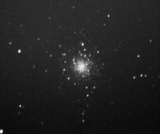
Messier 79
Encyclopedia
Messier 79 is a globular cluster
in the Lepus constellation. It was discovered by Pierre Méchain
in 1780. M79 is at a distance of about 41,000 light years away from Earth
and 60,000 light years away from the Galactic Center
.
Like Messier 54
(the other extragalactic globular on Messier's list), it is thought that M79 is not native to the Milky Way
galaxy at all, but instead to the Canis Major Dwarf Galaxy
which is currently experiencing a very close encounter with the Milky Way—one it is unlikely to survive intact. This is, however, a contentious subject as astronomers are still debating the nature of the Canis Major dwarf galaxy itself.
From the diagram it is evident that, most of the stars in this cluster are red giants. The elongated branch is Red giant branch. Stars in the upper left sequence extending outwards from the branch and some stars at the very low temperature end are actually foreground stars.
Altogether 3 regions of HRD are present here: low mass end of the main sequence
, complete red giant branch and horizontal branch. In infrared red stars are brighter, that's why red stars are brighter in this diagram making the lower main sequence shallower than usual. On the other hand the horizontal branch becomes steeper in this diagram due to IR effects (on the HB the blue end is fainter and the red end is brighter).
Globular cluster
A globular cluster is a spherical collection of stars that orbits a galactic core as a satellite. Globular clusters are very tightly bound by gravity, which gives them their spherical shapes and relatively high stellar densities toward their centers. The name of this category of star cluster is...
in the Lepus constellation. It was discovered by Pierre Méchain
Pierre Méchain
Pierre François André Méchain was a French astronomer and surveyor who, with Charles Messier, was a major contributor to the early study of deep sky objects and comets.-Life:...
in 1780. M79 is at a distance of about 41,000 light years away from Earth
Earth
Earth is the third planet from the Sun, and the densest and fifth-largest of the eight planets in the Solar System. It is also the largest of the Solar System's four terrestrial planets...
and 60,000 light years away from the Galactic Center
Galactic Center
The Galactic Center is the rotational center of the Milky Way galaxy. It is located at a distance of 8.33±0.35 kpc from the Earth in the direction of the constellations Sagittarius, Ophiuchus, and Scorpius where the Milky Way appears brightest...
.
Like Messier 54
Messier 54
Messier 54 is a globular cluster in the constellation Sagittarius. It was discovered by Charles Messier in 1778 and subsequently included in his catalog of comet-like objects....
(the other extragalactic globular on Messier's list), it is thought that M79 is not native to the Milky Way
Milky Way
The Milky Way is the galaxy that contains the Solar System. This name derives from its appearance as a dim un-resolved "milky" glowing band arching across the night sky...
galaxy at all, but instead to the Canis Major Dwarf Galaxy
Canis Major Dwarf Galaxy
The Canis Major Dwarf Galaxy is located in the same part of the sky as the constellation Canis Major. The galaxy contains a relatively high percentage of red giant stars, and is thought to contain an estimated one billion stars in all....
which is currently experiencing a very close encounter with the Milky Way—one it is unlikely to survive intact. This is, however, a contentious subject as astronomers are still debating the nature of the Canis Major dwarf galaxy itself.
Color-magnitude diagram
This color-magnitude diagram was made using infrared images of Messier 79 in two bands- J and K. J-band magnitude is plotted along y-axis and color, J-K, is plotted along x-axis. The image was created using Peter Stetson standard for clouded-field photometry, Daophot.From the diagram it is evident that, most of the stars in this cluster are red giants. The elongated branch is Red giant branch. Stars in the upper left sequence extending outwards from the branch and some stars at the very low temperature end are actually foreground stars.
Altogether 3 regions of HRD are present here: low mass end of the main sequence
Main sequence
The main sequence is a continuous and distinctive band of stars that appears on plots of stellar color versus brightness. These color-magnitude plots are known as Hertzsprung–Russell diagrams after their co-developers, Ejnar Hertzsprung and Henry Norris Russell...
, complete red giant branch and horizontal branch. In infrared red stars are brighter, that's why red stars are brighter in this diagram making the lower main sequence shallower than usual. On the other hand the horizontal branch becomes steeper in this diagram due to IR effects (on the HB the blue end is fainter and the red end is brighter).

